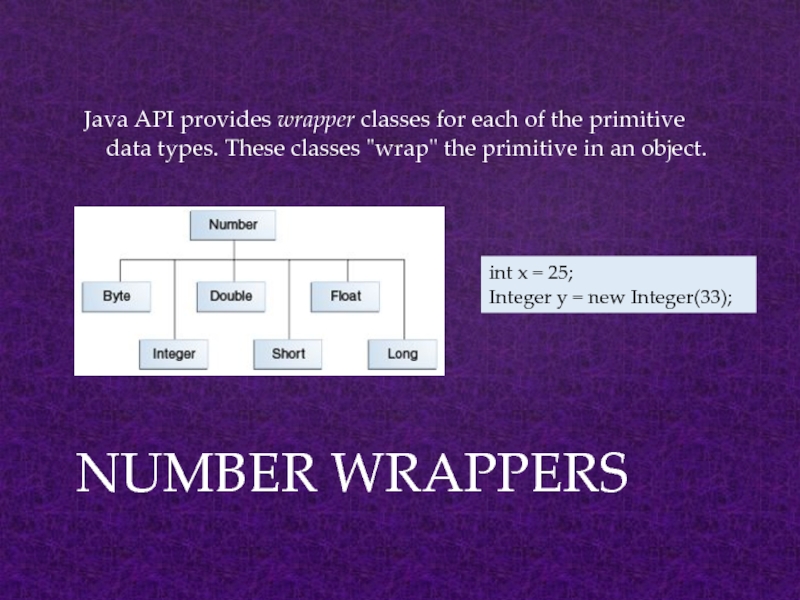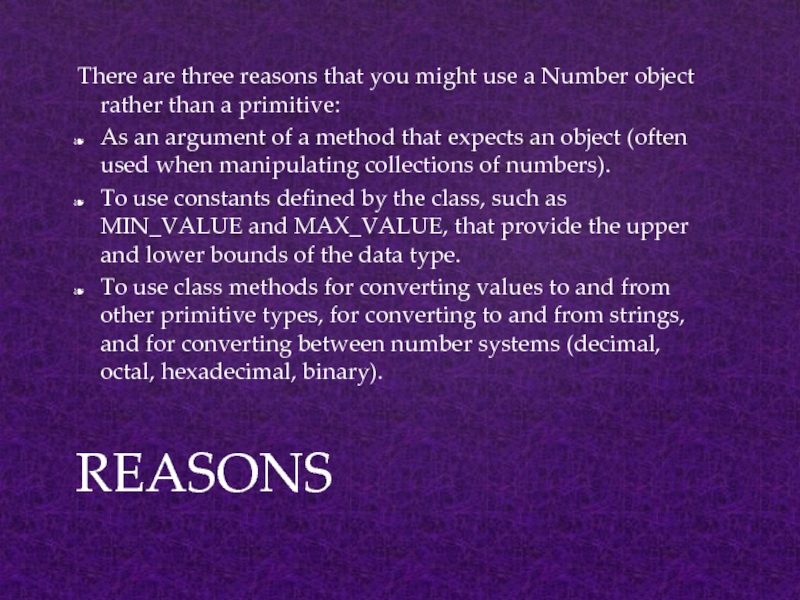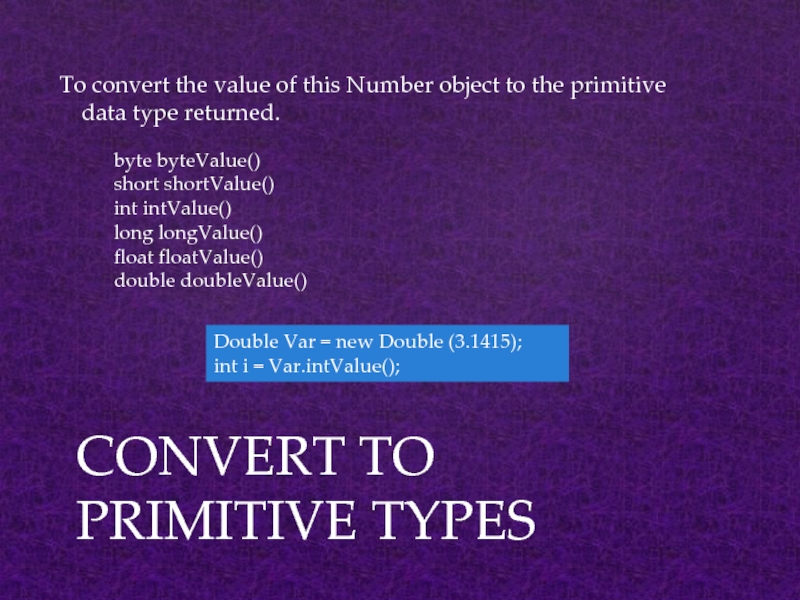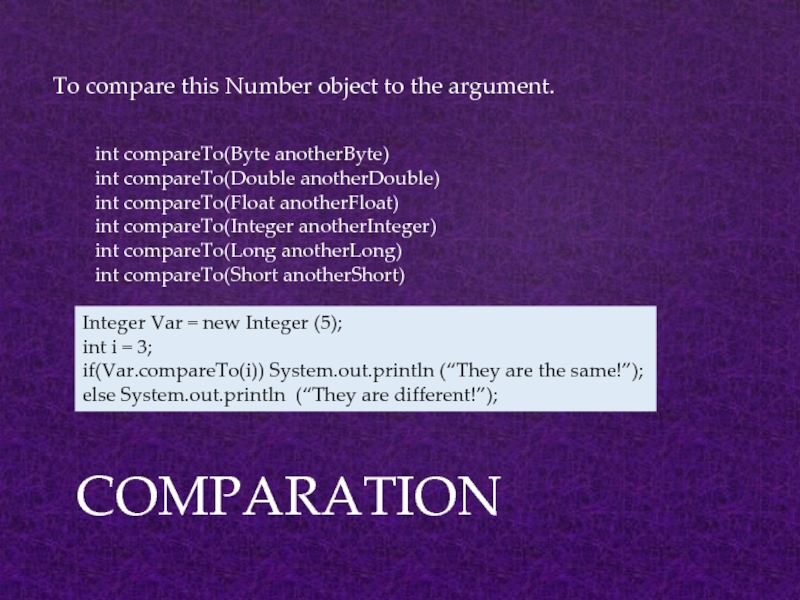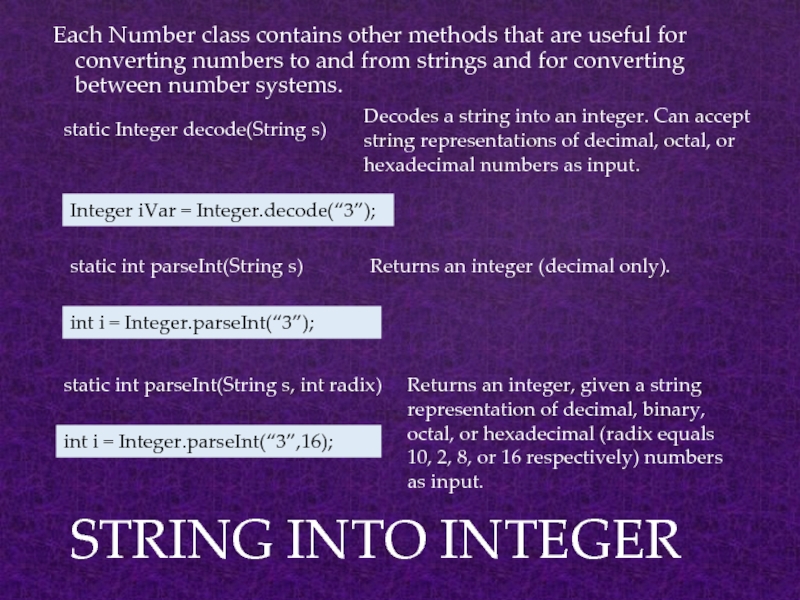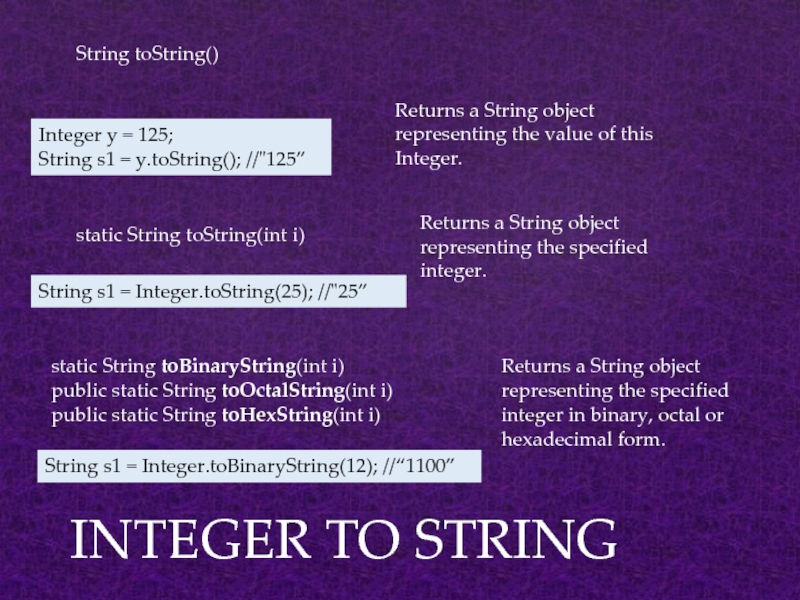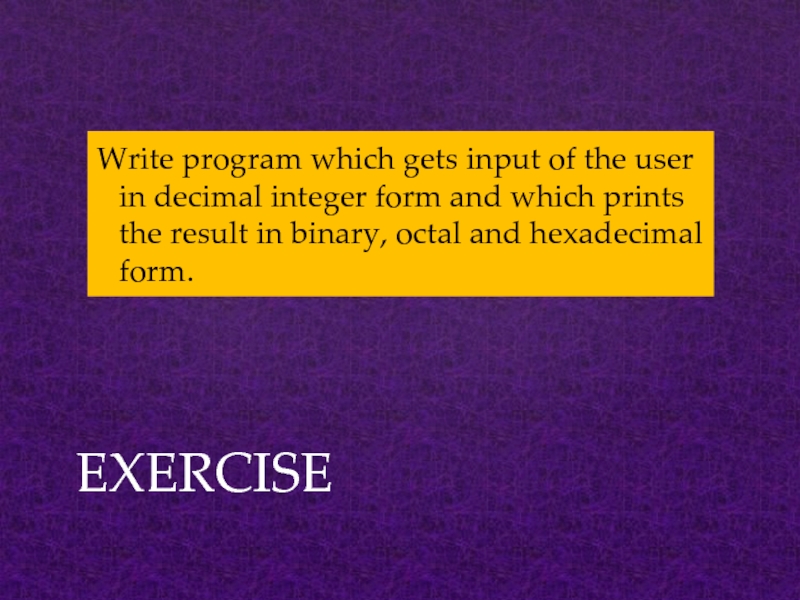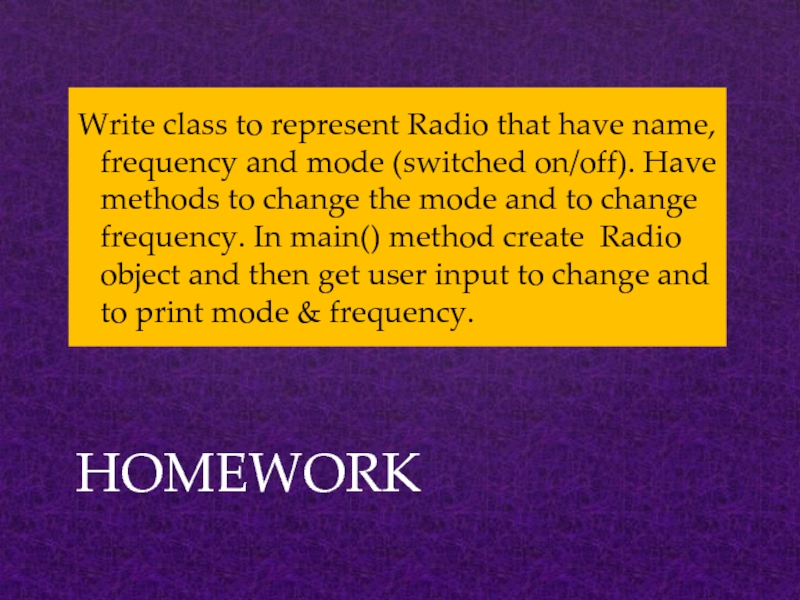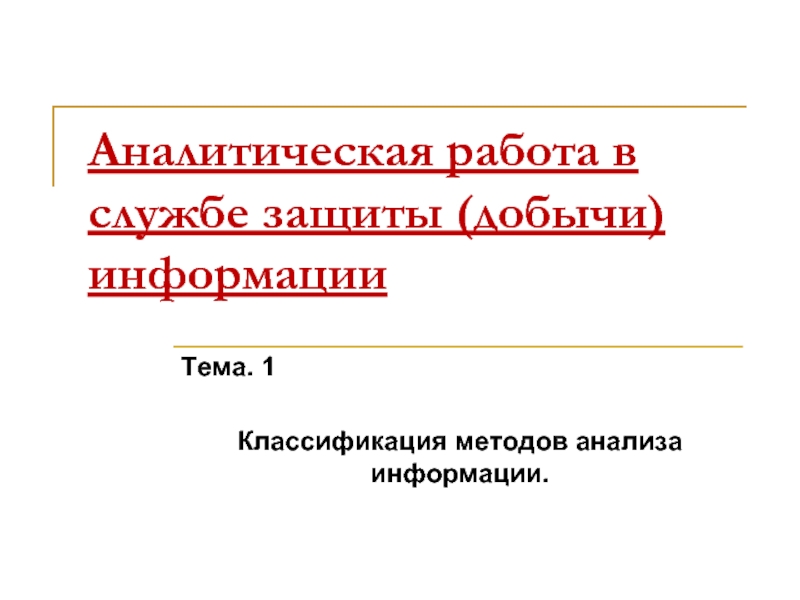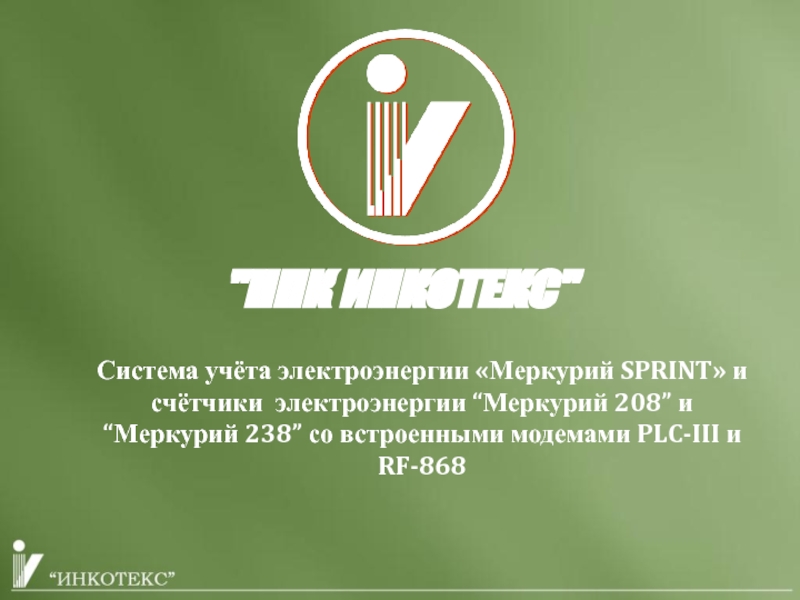- Главная
- Разное
- Дизайн
- Бизнес и предпринимательство
- Аналитика
- Образование
- Развлечения
- Красота и здоровье
- Финансы
- Государство
- Путешествия
- Спорт
- Недвижимость
- Армия
- Графика
- Культурология
- Еда и кулинария
- Лингвистика
- Английский язык
- Астрономия
- Алгебра
- Биология
- География
- Детские презентации
- Информатика
- История
- Литература
- Маркетинг
- Математика
- Медицина
- Менеджмент
- Музыка
- МХК
- Немецкий язык
- ОБЖ
- Обществознание
- Окружающий мир
- Педагогика
- Русский язык
- Технология
- Физика
- Философия
- Химия
- Шаблоны, картинки для презентаций
- Экология
- Экономика
- Юриспруденция
Java technology classes and objects презентация
Содержание
- 1. Java technology classes and objects
- 2. Start and finish Break Facilities, telephones and messages Questions and discussions LOGISTICS
- 3. CLASS Class Fields … Methods Attributes
- 4. OBJECT An object has identity (it acts
- 5. EXAMPLES Objects Non-objects A pen The upper 37
- 6. EXERCISE Consider a tube of four yellow
- 7. SOFTWARE OBJECTS Question: What are software
- 8. SOFTWARE CLASS A class is a
- 9. CLASS EXAMPLE Internet Merchandise Fields
- 10. OBJECT EXAMPLE SHOTGUN Fields “FAIR
- 11. class { field; method; } A
- 12. EXAMPLE Write class Vehicle that have attributes
- 13. Code that is outside the object's class
- 14. EXERCISE Write program that sets different values
- 15. Use an object reference to invoke an
- 16. EXERCISE Add method to calculate effectiveness into
- 17. CLASS STRING String is a very
- 18. STRING METHODS String machine = “pentium”; int
- 19. EXAMPLE class stringTester { public static
- 20. Java API provides wrapper classes for each
- 21. There are three reasons that you might
- 22. To convert the value of this Number
- 23. To compare this Number object to the
- 24. Each Number class contains other methods that
- 25. INTEGER TO STRING String toString() Returns a
- 26. Write program which gets input of the
- 27. Write class to represent Radio that have
- 28. QUESTIONS?
Слайд 3CLASS
Class
Fields
…
Methods
Attributes
Functions
Class is abstact data type.
Class denotes category of objects, and
Слайд 4OBJECT
An object has identity (it acts as a single whole).
An object
An object has behavior (it can do things and can have things done to it).
Object is entity that has the following features:
Слайд 5EXAMPLES
Objects Non-objects
A pen The upper 37 % of the pen
A Computer
A shoe The color black
A desk All desks in the world
Слайд 6EXERCISE
Consider a tube of four yellow tennis balls.
Is the tube
Is each tennis ball an object?
Could the top two balls be considered a single object?
Is the color of the balls an object?
Is your understanding of tennis balls an object?
Слайд 7SOFTWARE OBJECTS
Question: What are software objects made out of?
Answer:
Software objects have identity because each is a separate chunk of memory having name.
Software objects have state. Some of the memory that makes a software object is used for attributes which contain values.
Software objects have behavior. Some of the memory that makes a software object is used to contain programs (called methods) that enable the object to "do things." The object does something when one of its method runs.
Слайд 8SOFTWARE CLASS
A class is a description of a kind of
A programmer may define a class
or may use predefined classes that come in class libraries.
A class is merely a plan for a possible object (or objects.). It does not by itself create any objects.
When a programmer wants to create an object the new operator is used with the name of the class.
Creating an object is called instantiation.
Слайд 9CLASS EXAMPLE
Internet Merchandise
Fields
“Name”,
“Price“,
“Producer”,
“Type”,
“Photo”
Methods
“Make discount”,
“Set
“Add photo”
Слайд 10OBJECT EXAMPLE
SHOTGUN
Fields
“FAIR X-Light”
“120000 rubles”
“Italy”
“Sporting Goods”
“http://www.fair.it/media/img/prodotti/xlight_prestige_b.jpg”
Methods
“Make discount”,
“Set name”,
“Add photo”
Object of same class have same structure, it exhibits properties & behaviors defined by its class.
Properties is also called as attributes/fields & behaviors as methods/operations.
Слайд 11class {
field;
method;
}
A class in java can contain:
field
method
constructor
block
class and interface
CLASS IN JAVA
Слайд 12EXAMPLE
Write class Vehicle that have attributes (fields) speed и power.
Declare
public class Vehicle{
int speed;
double power;
}
Vehicle auto;
Vehicle moto = null;
Create objects auto and moto by new keyword.
auto = new Vehicle();
moto = new Vehicle();
Слайд 13Code that is outside the object's class must use an object
objectReference.fieldName
GET & SET ATTRIBUTES
To get: variable = object.field;
To set: object.field = variable;
Слайд 14EXERCISE
Write program that sets different values for the fields:
auto.power =
auto.speed = 150;
moto.power = 24;
moto.speed = 120;
System.out.println(auto.power +” “+ auto.speed);
System.out.println(moto.power +” “+ moto.speed);
auto.speed = 180;
System.out.println(auto.power +” “+ auto.speed);
System.out.println(moto.power +” “+ moto.speed);
Every object has independent fields.
Слайд 15Use an object reference to invoke an object's method. Append the
objectReference.methodName(argumentList);
or:
objectReference.methodName();
CALLING METHODS
Слайд 16EXERCISE
Add method to calculate effectiveness into Vehicle class
double eff() {
return power/speed;
Compare 2 objects
System.out.print(auto.eff()>moto.eff());
The objects must be created to use method eff().
Слайд 17CLASS STRING
String is a very special class in Java.
String here=“I am here”;
here=“I am there”;//previous one is completely deleted
Our rules and dictionaries can be stored string class.
This class is armed with useful methods
compareTo(String str),
concate(String str),
endsWith(String str),
indexOf(int ch),
length(),
startsWith(String str),
lastIndexOf(String str).
Слайд 18STRING METHODS
String machine = “pentium”;
int comp = machine.compareTo(“pentium”); //comp=0;
String lab= “Language”;
lab=lab.concate(“
int ind = machine.indexOf(‘t’);
boolean start = machine.startsWith(“pen”); //true
boolean end = machine.endsWith(“um”); //true
String part1=machine.substring(0,3); //part1=“pen”;
String part2=machine.substring(5);//part2=“um”;
Слайд 19EXAMPLE
class stringTester {
public static void main ( String[] args )
String str1; // str1 is a variable that refers to an object,
// but the object does not exist yet.
int len; // len is a primitive variable of type int
str1 = new String(“Bullet is waiting…"); // create an object of type String
len = str1.length(); // invoke the object's method length() System.out.println("The string is " + len + " characters long");
}
}
Слайд 20Java API provides wrapper classes for each of the primitive data
NUMBER WRAPPERS
int x = 25;
Integer y = new Integer(33);
Слайд 21There are three reasons that you might use a Number object
As an argument of a method that expects an object (often used when manipulating collections of numbers).
To use constants defined by the class, such as MIN_VALUE and MAX_VALUE, that provide the upper and lower bounds of the data type.
To use class methods for converting values to and from other primitive types, for converting to and from strings, and for converting between number systems (decimal, octal, hexadecimal, binary).
REASONS
Слайд 22To convert the value of this Number object to the primitive
CONVERT TO PRIMITIVE TYPES
byte byteValue()
short shortValue()
int intValue()
long longValue()
float floatValue()
double doubleValue()
Double Var = new Double (3.1415);
int i = Var.intValue();
Слайд 23To compare this Number object to the argument.
COMPARATION
int compareTo(Byte anotherByte)
int compareTo(Double
Integer Var = new Integer (5);
int i = 3;
if(Var.compareTo(i)) System.out.println (“They are the same!”);
else System.out.println (“They are different!”);
Слайд 24Each Number class contains other methods that are useful for converting
STRING INTO INTEGER
static Integer decode(String s)
Decodes a string into an integer. Can accept string representations of decimal, octal, or hexadecimal numbers as input.
Integer iVar = Integer.decode(“3”);
static int parseInt(String s)
Returns an integer (decimal only).
int i = Integer.parseInt(“3”);
static int parseInt(String s, int radix)
Returns an integer, given a string representation of decimal, binary, octal, or hexadecimal (radix equals 10, 2, 8, or 16 respectively) numbers as input.
int i = Integer.parseInt(“3”,16);
Слайд 25INTEGER TO STRING
String toString()
Returns a String object representing the value of
Integer y = 125;
String s1 = y.toString(); //"125”
static String toString(int i)
Returns a String object representing the specified integer.
String s1 = Integer.toString(25); //"25”
static String toBinaryString(int i)
public static String toOctalString(int i)
public static String toHexString(int i)
Returns a String object representing the specified integer in binary, octal or hexadecimal form.
String s1 = Integer.toBinaryString(12); //“1100”
Слайд 26Write program which gets input of the user in decimal integer
EXERCISE
Слайд 27Write class to represent Radio that have name, frequency and mode
HOMEWORK
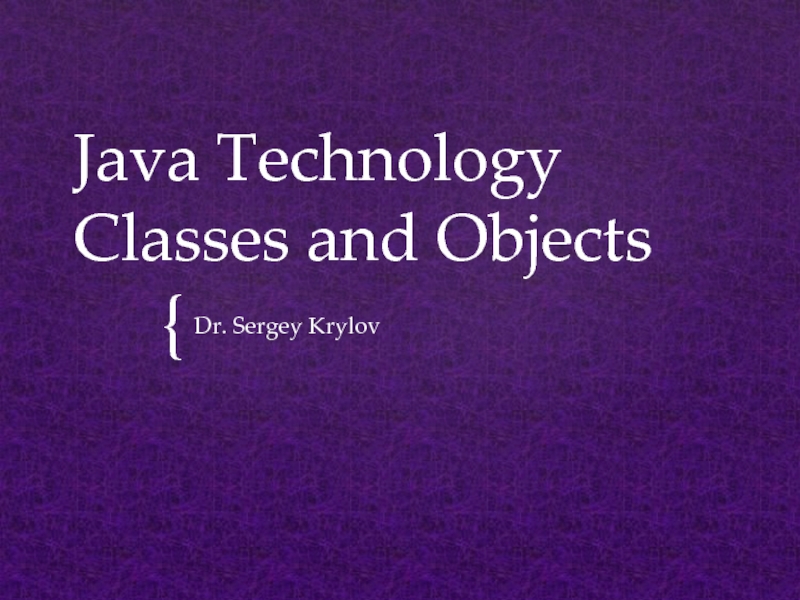
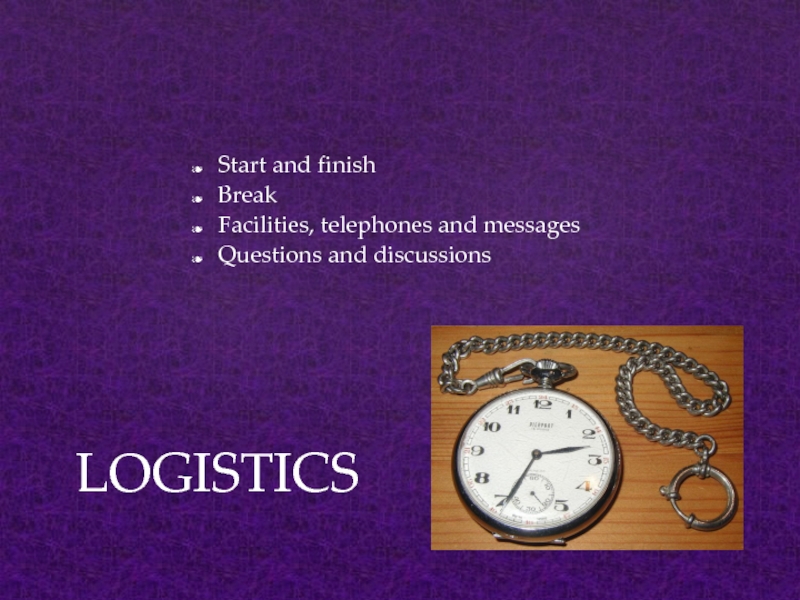
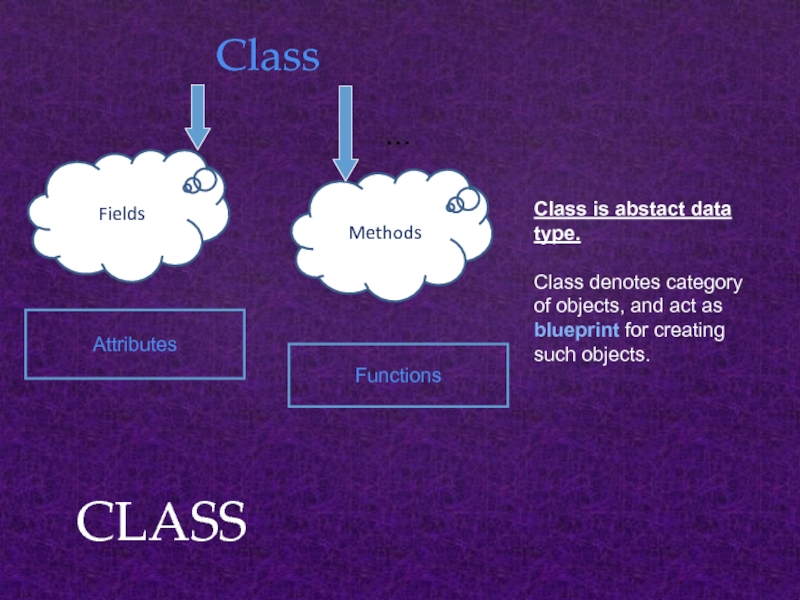
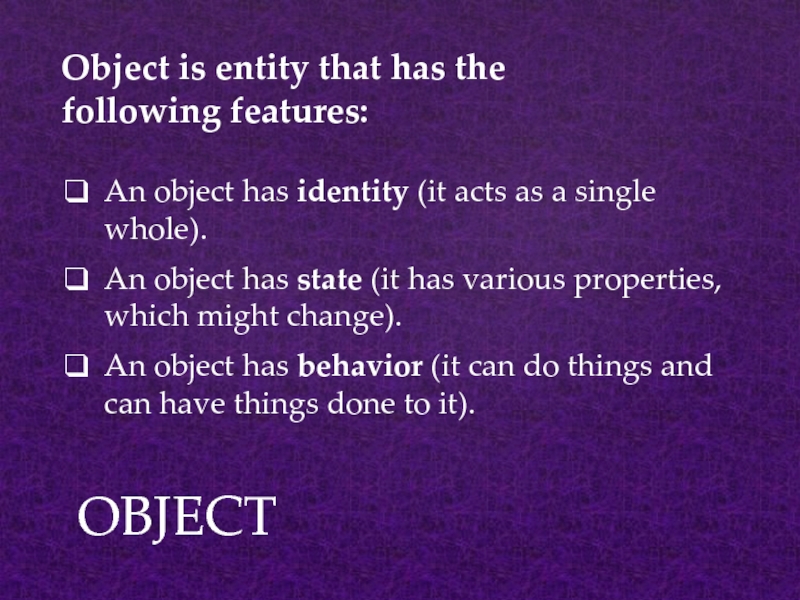
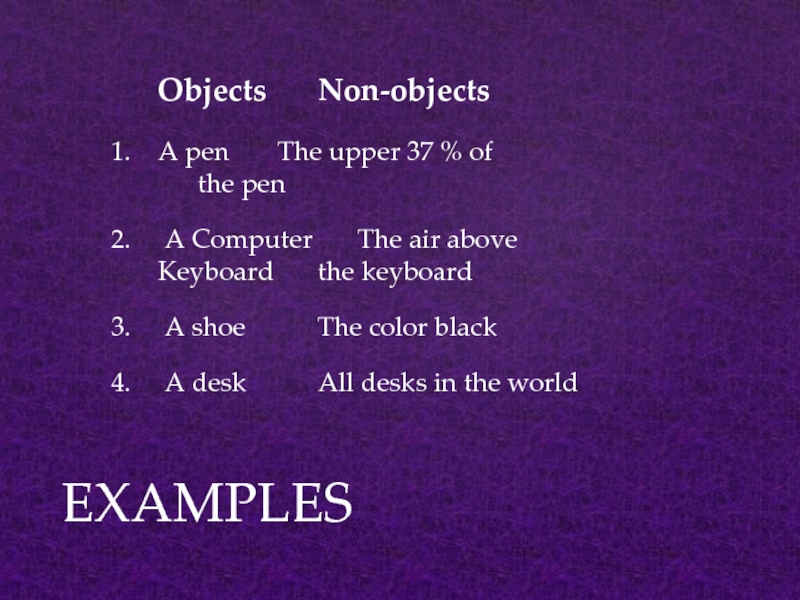
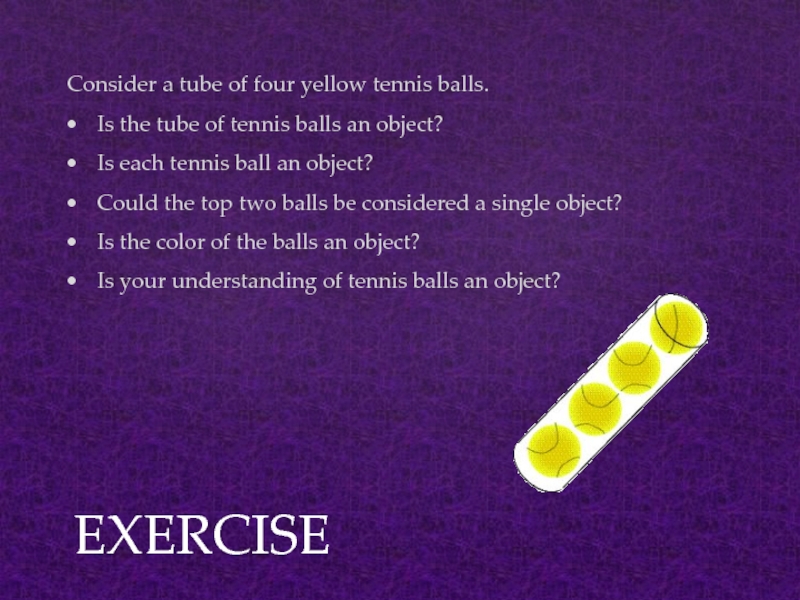
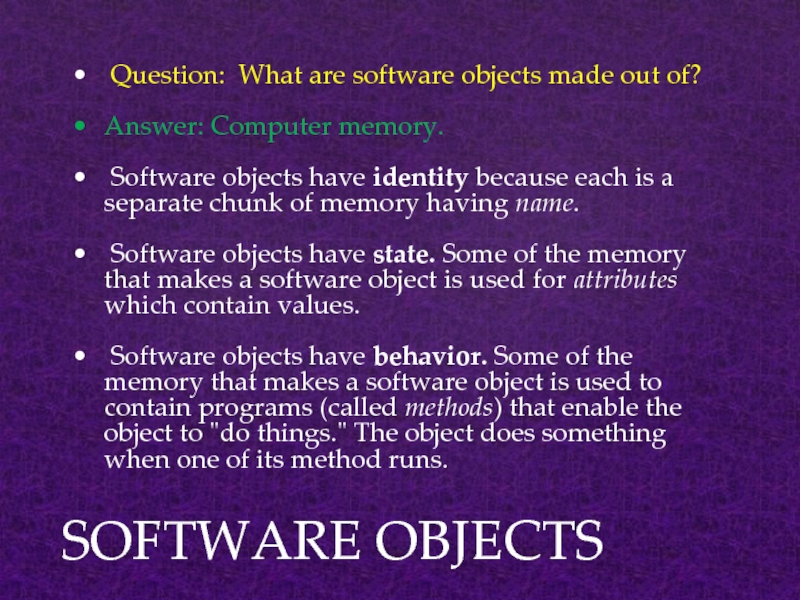
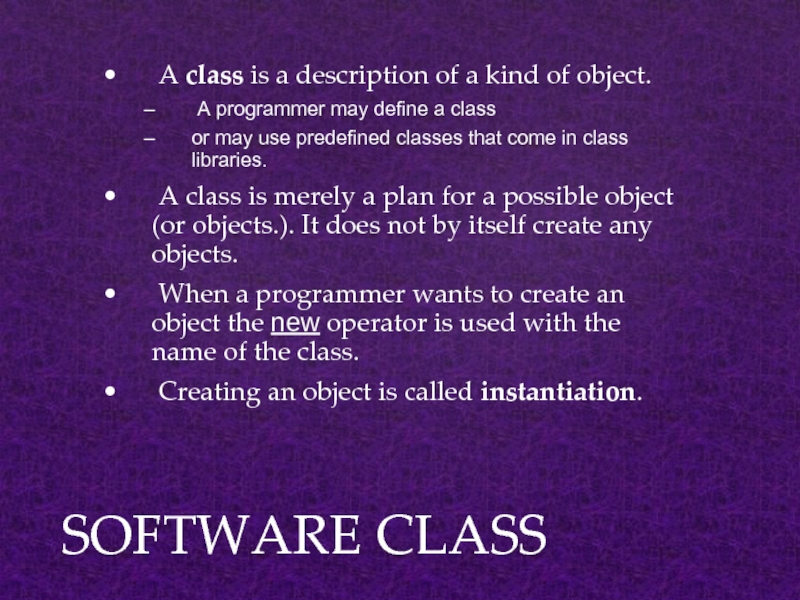
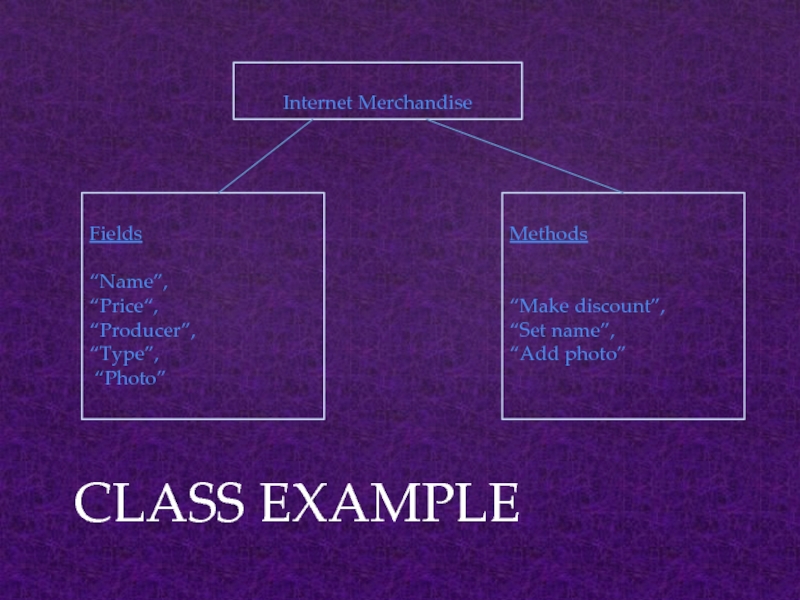
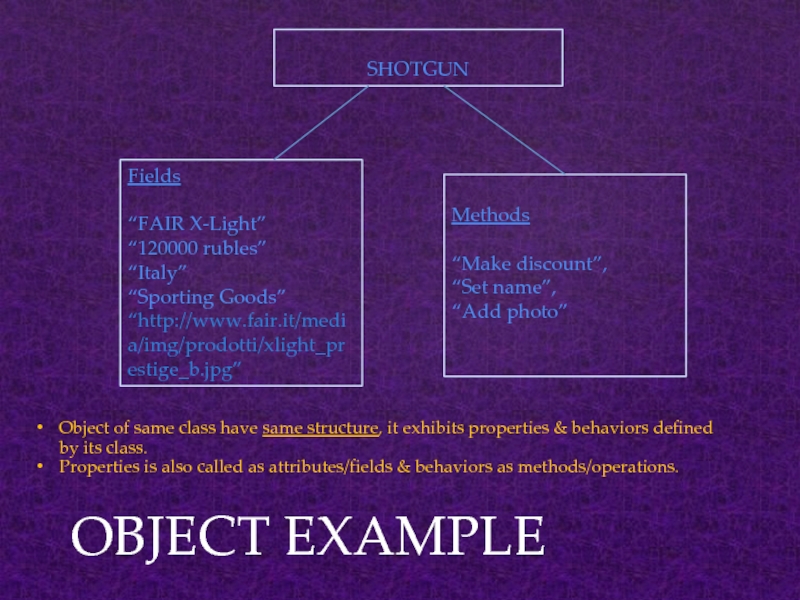
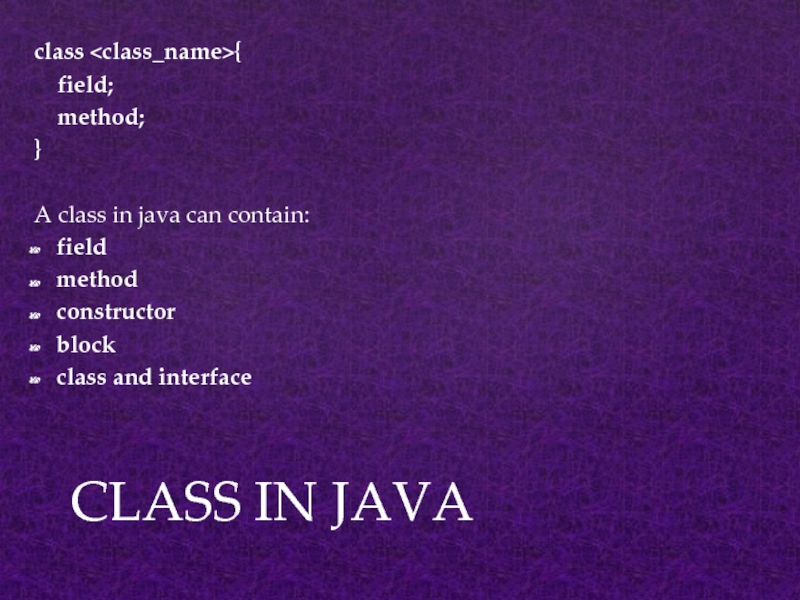
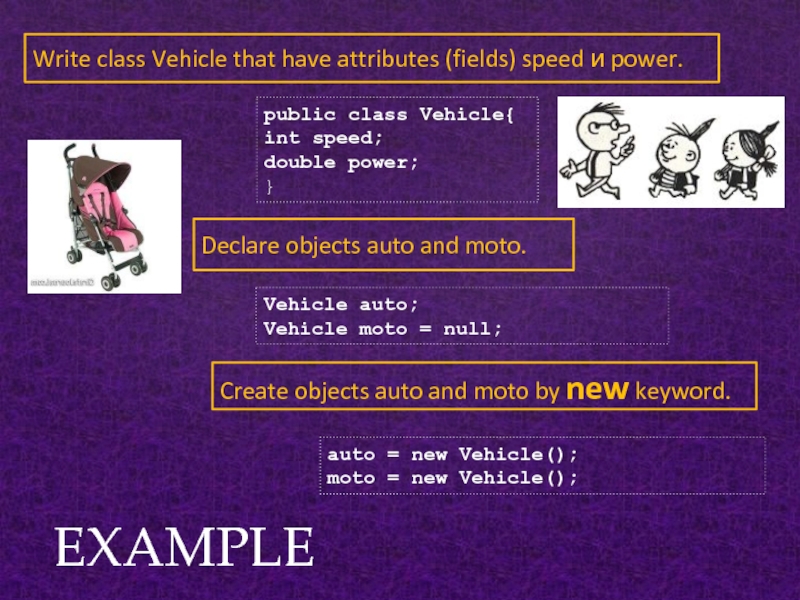
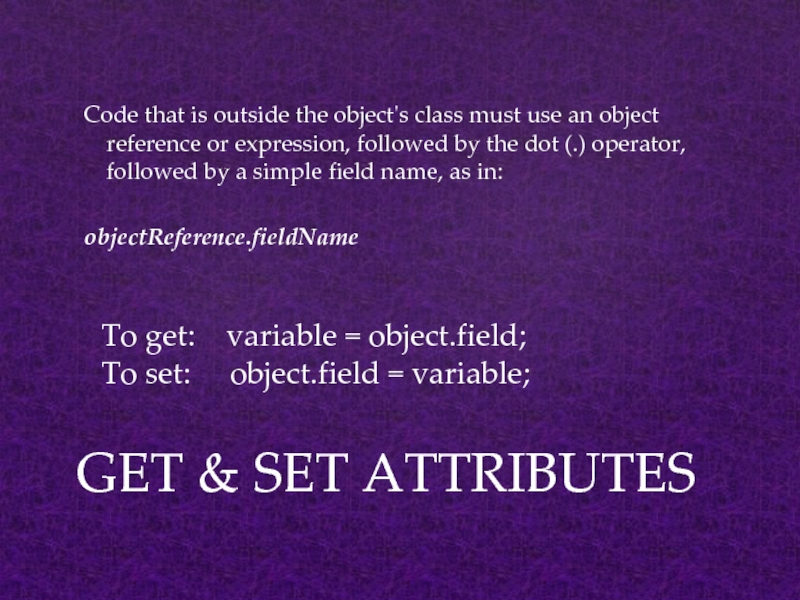
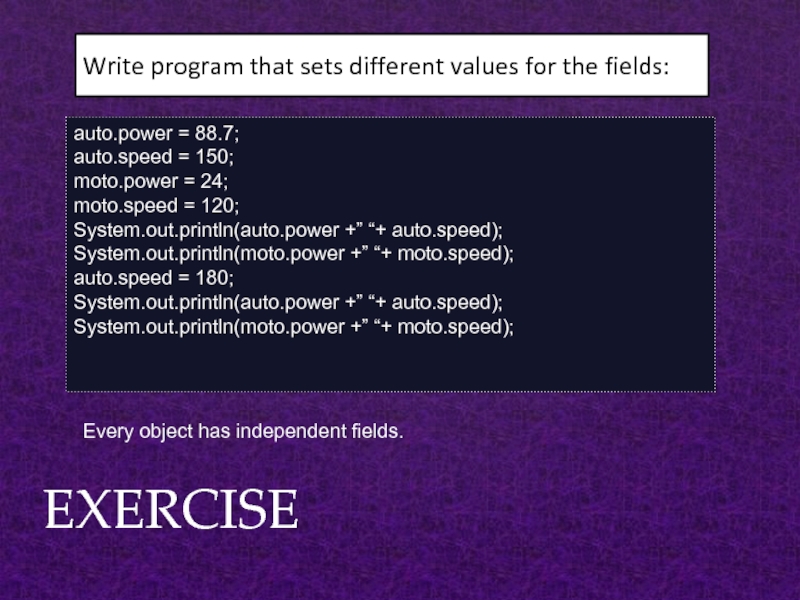
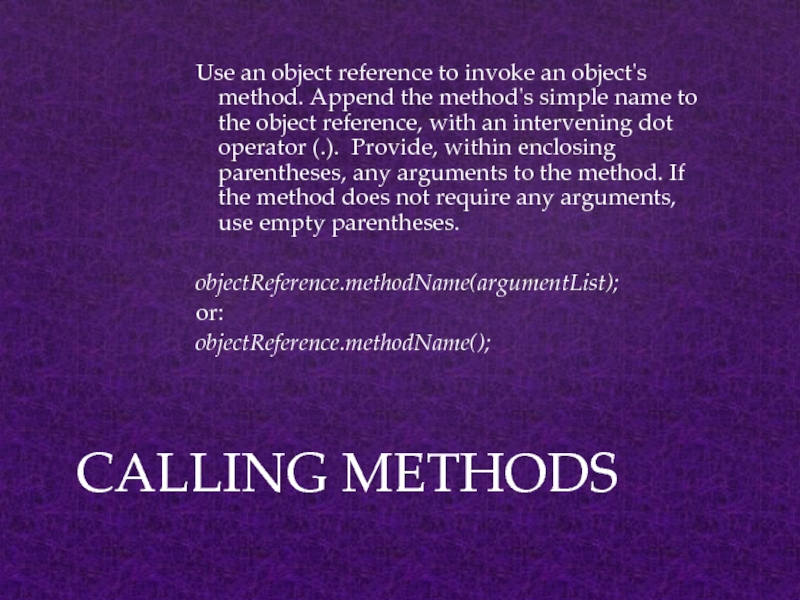
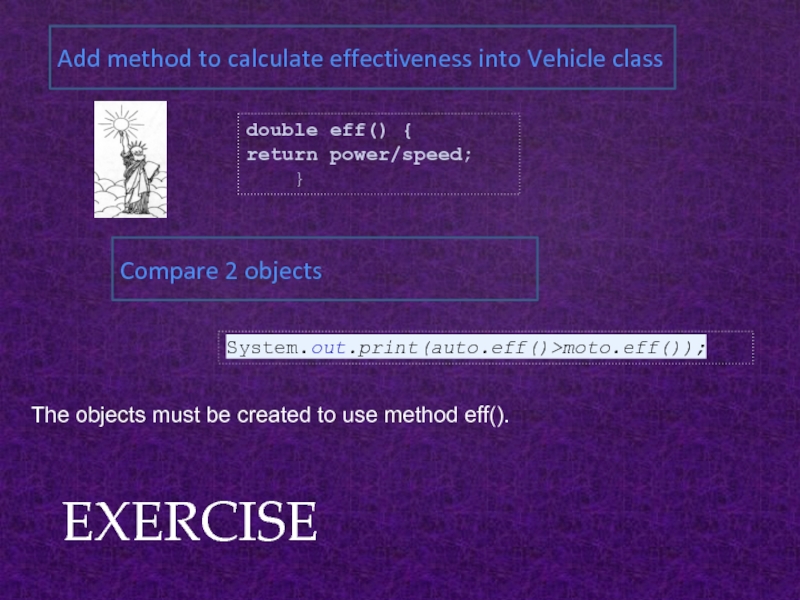
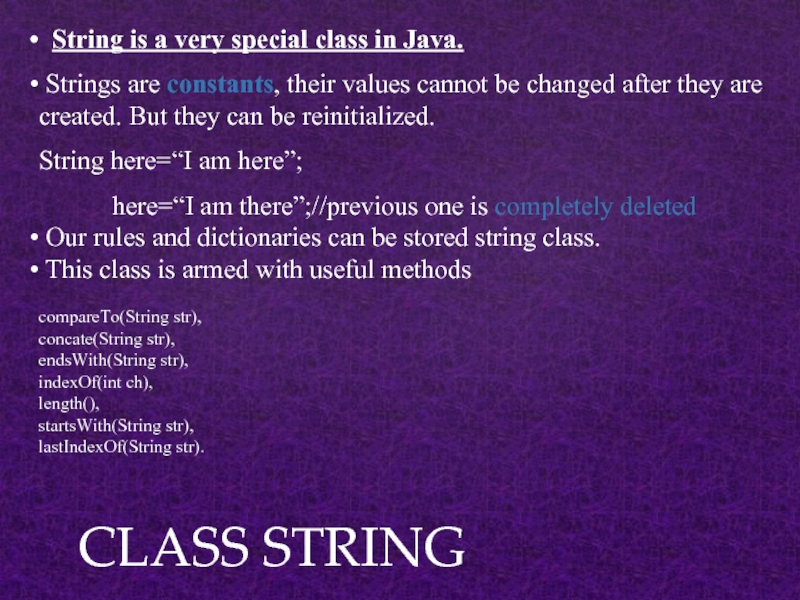
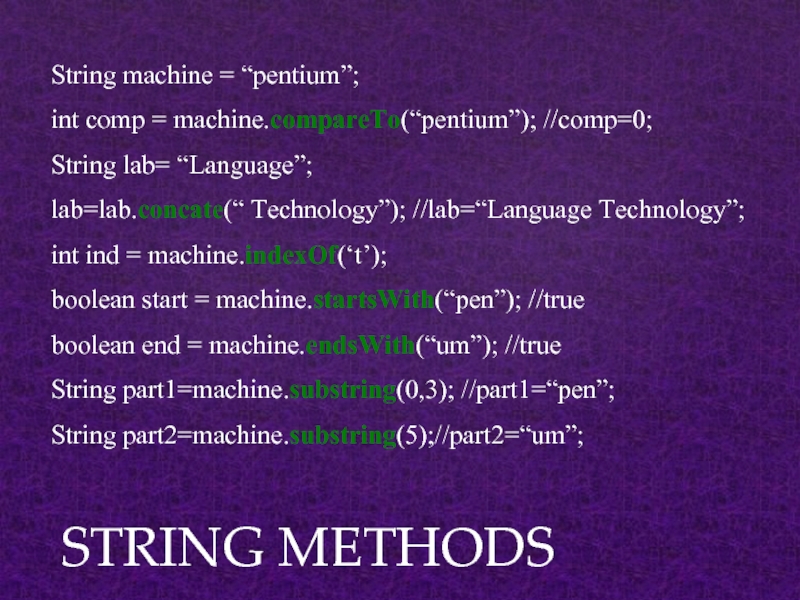
![EXAMPLEclass stringTester { public static void main ( String[] args ) { String str1;](/img/tmb/1/95730/2bfa55e2af358eab3029047b3eb3feca-800x.jpg)
